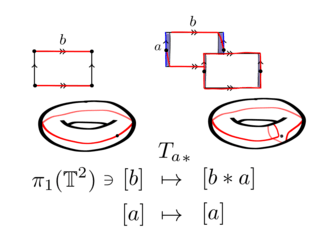Dehn twist

In geometric topology, a branch of mathematics, a Dehn twist is a certain type of self-homeomorphism of a surface (two-dimensional manifold).
Definition

Suppose that c is a simple closed curve in a closed, orientable surface S. Let A be a tubular neighborhood of c. Then A is an annulus and so is homeomorphic to the Cartesian product of
where I is the unit interval. Give A coordinates (s, t) where s is a complex number of the form
with
and t in the unit interval.
Let f be the map from S to itself which is the identity outside of A and inside A we have
Then f is a Dehn twist about the curve c.
Dehn twists can also be defined on a non-orientable surface S, provided one starts with a 2-sided simple closed curve c on S.
Example


Consider the torus represented by a fundamental polygon with edges a and b
Let a closed curve be the line along the edge a called .
Given the choice of gluing homeomorphism in the figure, a tubular neighborhood of the curve will look like a band linked around a doughnut. This neighborhood is homeomorphic to an annulus, say
in the complex plane.
By extending to the torus the twisting map of the annulus, through the homeomorphisms of the annulus to an open cylinder to the neighborhood of , yields a Dehn twist of the torus by a.
This self homeomorphism acts on the closed curve along b. In the tubular neighborhood it takes the curve of b once along the curve of a.
A homeomorphism between topological spaces induces a natural isomorphism between their fundamental groups. Therefore one has an automorphism
where [x] are the homotopy classes of the closed curve x in the torus. Notice and , where is the path travelled around b then a.
Mapping class group

It is a theorem of Max Dehn that maps of this form generate the mapping class group of isotopy classes of orientation-preserving homeomorphisms of any closed, oriented genus- surface. W. B. R. Lickorish later rediscovered this result with a simpler proof and in addition showed that Dehn twists along explicit curves generate the mapping class group (this is called by the punning name "Lickorish twist theorem"); this number was later improved by Stephen P. Humphries to , for , which he showed was the minimal number.
Lickorish also obtained an analogous result for non-orientable surfaces, which require not only Dehn twists, but also "Y-homeomorphisms."
See also
References
- Andrew J. Casson, Steven A Bleiler, Automorphisms of Surfaces After Nielsen and Thurston, Cambridge University Press, 1988. ISBN 0-521-34985-0.
- Stephen P. Humphries, Generators for the mapping class group, in: Topology of low-dimensional manifolds (Proc. Second Sussex Conf., Chelwood Gate, 1977), pp. 44–47, Lecture Notes in Math., 722, Springer, Berlin, 1979. MR0547453
- W. B. R. Lickorish, A representation of orientable combinatorial 3-manifolds. Ann. of Math. (2) 76 1962 531—540. MR0151948
- W. B. R. Lickorish, A finite set of generators for the homeotopy group of a 2-manifold, Proc. Cambridge Philos. Soc. 60 (1964), 769–778. MR0171269